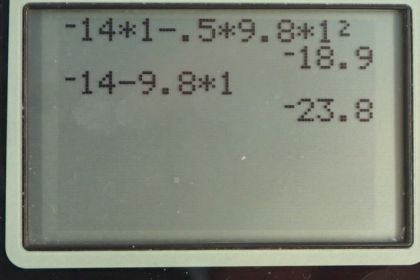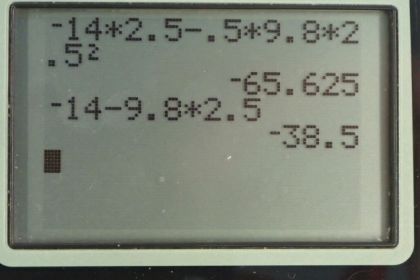Question
Calculate the displacement and velocity at times of (a) 0.500, (b) 1.00, (c) 1.50, (d) 2.00, and (e) 2.50 s for a rock thrown straight down with an initial velocity of 14.0 m/s from the Verrazano Narrows Bridge in New York City. The roadway of this bridge is 70.0 m above the water.
Final Answer
- ,
- ,
- ,
- ,
- ,
Solution video
OpenStax College Physics for AP® Courses, Chapter 2, Problem 42 (Problems & Exercises)

vote with a rating of
votes with an average rating of
.
Calculator Screenshots
Video Transcript
This is College Physics Answers with Shaun Dychko. A stone is thrown down from the Verrazzano-Narrows Bridge in New York city. The bridge is 70 meters above the water and we'll take y naught to be the bridge level and we'll take the water to be 70 meters below that and so we have negative 70 meters for the position of the water since we are assuming that upwards is the positive direction. So the bridge is here and the water is here and we have defined this bridge level to be our zero position for the y-axis and then this will then become negative 70 meters. Okay. So the rock is thrown downwards with some initial velocity and that is v naught and we'll give that a negative sign as well because it's in the downward direction and we have defined up to be positive. So the initial velocity is negative 14.0 meters per second and the question (a), (b), (c), (d) and (e) ask us for the displacement and the maximum velocity at five different times. So for part (a), our time, t 1, is 0.5 seconds after being thrown and it's position, y 1, is going to be its displacement since we have taken y naught to be zero. So y 1 then is this initial position, which is zero, plus this initial velocity which is negative 14 meters per second multiplied by this time t 1 minus one-half times acceleration due to gravity times t 1 squared; this is equation 76 from chapter 2 and we can rewrite it with y naught taken away because it is zero and so this y 1 is v naught t 1 minus one-half gt 1 squared and then we plug in numbers into it. So y 1 is negative 14 meters per second times 0.500 seconds minus a half times 9.8 meters per second squared—acceleration due to gravity— times 0.500 seconds squared giving us negative 8.23 meters. So that's the displacement of a rock after half a second. It's maximum speed, v 1, is gonna be its initial speed, v naught, minus acceleration due to gravity multiplied by time; this is equation 75 from chapter 2. So that's negative 14 meters per second minus 9.8 meters per second squared times 0.500 seconds giving a final speed of negative 18.9 meters per second and I should be saying final velocity, not final speed because this is directional and that's why there's a negative sign there to indicate that the direction is downwards. So this is v 1 is the final velocity after 0.500 seconds. So part (b) says consider the time t 2 which is 1.00 seconds. So the formulas are all going to be the same so I'm just writing in numbers at this point; we are using the same formula v naught times t minus one-half gt squared, where t is whatever time we are considering in the different parts so in this case, it's t 2 which is 1 second. So y 2 is negative 14 meters per second— initial velocity— multiplied by 1 second minus a half times 9.8 meters per second squared times 1.00 second squared giving negative 18.9 meters is the displacement after 1 second. And the final velocity for the second time interval is negative 14 meters per second minus 9.8 meters per second squared times 1 second which is negative 23.8 meters per second. And then after time interval three, which is 1.50 seconds, the displacement will be the same formula with 1.50 instead of 1 or 0.5 and that gives negative 32.0 meters and v 3 will be negative 14 meters per second minus 9.8 meters per second squared times 1.50 seconds giving negative 28.7 meters per second. And t 4 is 2 seconds and so the displacement after this fourth time interval is negative 14.0 meters per second times 2 seconds minus a half times acceleration due to gravity times 2 seconds squared which is negative 47.6 meters and v 4 is going to be this initial velocity minus acceleration due to gravity multiplied by 2 seconds which is negative 33.6 meters per second. And lastly, we have the fifth time interval which is 2.50 seconds in which case the displacement is going to be negative 14 meters per second times 2.50 seconds minus a half times acceleration due to gravity times 2.50 seconds squared which is negative 65.6 meters and this is getting pretty close to the water now because the water is at negative 70 meters and this final velocity is going to be, with 2.50 seconds substituted in, for a total velocity of negative 38.5 meters per second.




